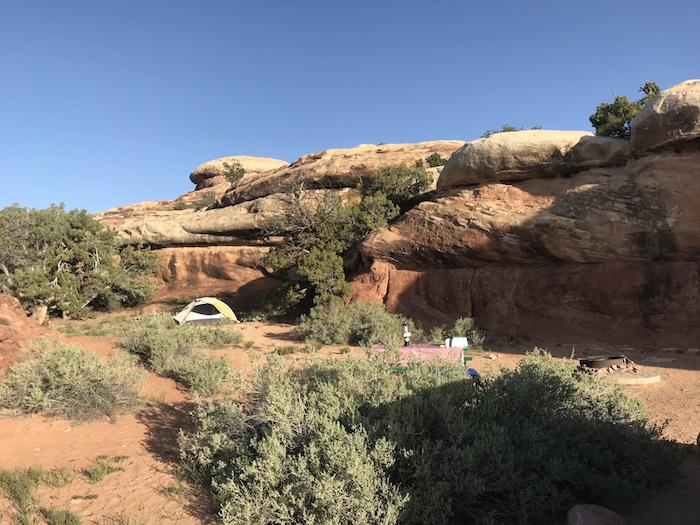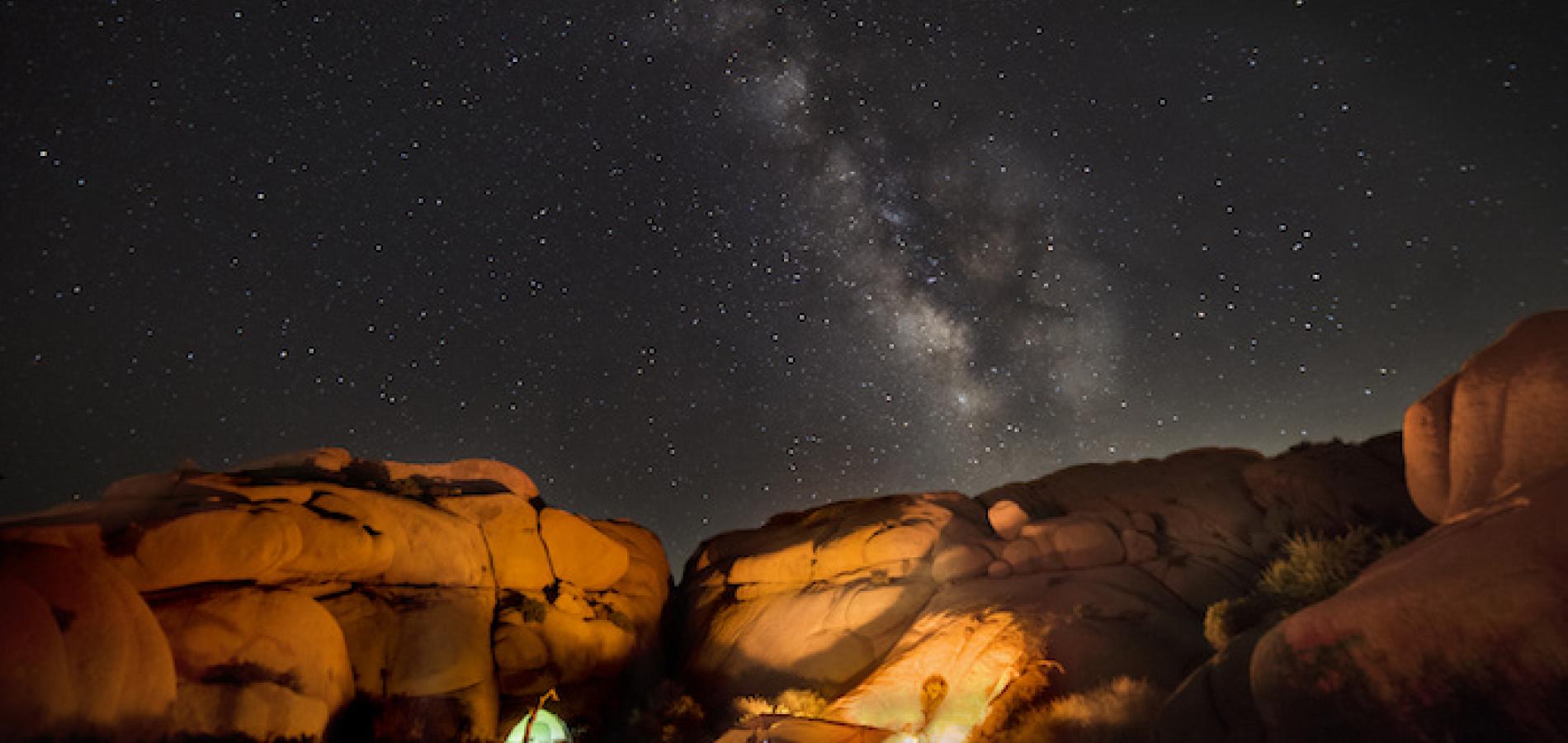Editor's note: Wyoming-based writer Kristen Pope, who is no stranger to the National Park System, took some time to recommend some of her favorite campgrounds for our Essential Park Guide Summer 2018 edition.
A huge grizzly sauntered out of the campground and crossed the road right in front of our car as we pulled into Yellowstone National Park’s Madison Campground. We found our campsite and, as we were setting up our tent, chatted with our campground neighbors who were a bit unsettled by seeing the bear wander right by their site a few minutes before.
The next morning, we awoke to flashes of lightning and rumbles of thunder. As the storm grew closer, hail lashed against our tent and the ground shook with each boom of thunder. We contemplated whether we should stay in our tent or make a dash for the car, but soon the storm was over, the smell of freshly fallen rain filled the air, and the sun came out. We shook the droplets of rain off the tent and laid it out in a sunny spot to dry while eating breakfast and packing up. Even though there were hundreds of other campers in the campground, we were still in a wild, wonderful place. National park campgrounds open up a world of adventure with a wide variety of “lodging” options, from a tranquil spot to a festive frenzy of activity.
But, snagging a perfect site can be tricky since many prime campgrounds fill fast. Some sites can be reserved months in advance; others fill on a first-come, first-served basis. Some national parks track the average time that their campgrounds fill, so check the park’s website for that information. Since popular campgrounds fill early, sometimes before 7 a.m., be sure to plan ahead and have a back-up plan if your favored campground is unavailable.
Before camping, be sure to have all the equipment and knowledge you will need to do so safely. Not all campgrounds have water available, so be sure to have what you need. Inquire about local dangers, and always be aware of the weather, wildlife, and other potential hazards. It’s worth the effort. The following iconic and stunning campgrounds are just a taste of what the National Park System’s campgrounds have to offer.
Denali National Park and Preserve, Alaska
Camp beneath the towering white behemoth of Denali, North America’s tallest mountain. Although the 20,310-foot-tall mountain is 26 miles from the campground, it still looms large. Lucky campers are in prime position for a great view if the mountain is “out” (it is often obscured by clouds). The Wonder Lake Campground has just 28 tent-only sites, and is 85 miles into the national park. Campers take a shuttle bus to reach the campground. Watch pinks and purples dance over the mountain as alpenglow sets in each evening and, if you visit late enough in the season, keep your eyes peeled for the aurora borealis as it dances in the darkness. Moose, grizzlies, and even caribou are known to wander through the campground, and Wonder Lake sometimes hosts waterfowl and beaver. A mile-long trail leads from the campground to the McKinley River. Take appropriate precautions for grizzlies, and be prepared for mosquitoes with bug spray and a head net.

The Jenny Lake Campground in Grand Teton National is one of the most picturesque in the National Park System / Grand Teton Lodge Company
Grand Teton National Park, Wyoming
Nestled along Jenny Lake’s shores, the campground is a prime location for admiring the majestic Tetons. Glacial boulders and conifers complete the scenery at the park’s most popular campground. Only 49 sites are available for tent campers (plus 10 sites for hikers and bicyclists), and the campground fills early in the day, generally before 9 a.m. The Jenny Lake Store has snacks, ice, firewood, and other camping essentials. Grizzlies do frequent the area, so always take appropriate precautions when camping, hiking, and recreating in the area.
Belle Fourche River Campground
Devils Tower National Monument, Wyoming
Devils Tower rises up out of the prairie flats in northeastern Wyoming’s slice of the Black Hills. Many sites at the Belle Fourche River Campground allow views of the Tower, which rises 867 feet from base to summit. The first-come, first-served campground has 50 sites and is dotted with shading cottonwood trees. Plenty of hiking is available nearby, and recreational climbing is popular, though many Native Americans consider Devils Tower sacred and find recreational climbing on it to be disrespectful. The National Park Service encourages climbers to avoid the Tower or hiking within the Tower Trail Loop during the month of June to “balance American Indian cultural and ceremonial values associated with the Tower” with climbing.
Joshua Tree National Park, California
Campsites at Jumbo Rocks are scattered throughout spectacular rock formations that give the campground its name. There are granite domes and Joshua trees by day, celestial views at night in this designated International Dark Sky Park. The campground has 124 reserved sites, and is most popular in spring and fall, when temperatures moderate.
Cape Hatteras National Seashore, North Carolina
Located between rolling dunes and maritime forest, Cape Point Campground has 202 reserved sites. The campground is a short walk from the actual “Cape Hatteras.” The area is popular with surf casters, surfers, and birders. The 198-foot Cape Hatteras Lighthouse (the country’s tallest brick lighthouse) is located a bit to the north. Bring extra-long tent stakes for the sandy soil, pack sun protection since there is no shade, and bridge netting and repellent for biting insects.

Arguably the best campground in the Southwest is the Needles Campground in Canyonlands National Park. With just 27 sites, and stunning red-rock landscape in all directions, it offers rare solitude and incredible scenery. But it also can be brutally hot in summer, so plan your trips for the spring or fall / Kurt Repanshek
Acadia National Park, Maine
Located on the southern tip of Mount Desert Island, the Seawall Campground features 203 sites. Walk-in sites are 10-to-300 feet from the parking area, with many sites in the woods. The ocean is a 10-minute walk, and nearby Echo Lake is a popular place to enjoy fishing and canoeing.
Grand Canyon National Park, Arizona
Sunrise views are spectacular at Desert View Campground, just 25 miles east of Grand Canyon Village on the South Rim. The 50-site campground is quieter and less crowded than other campgrounds. However, it is still quite popular and its first-come, first-served sites fill early. Campers enjoy panoramic views even without reaching the top of the Desert View Watchtower
There are hundreds more campgrounds around the National Park System for you to sample on your travels. Just know that many parks have been witnessing great increases in visitation, and you should reserve a site as early as possible. More and more parks also don’t want you bringing firewood with you, out of concern for accidentally introducing invasive bug species. So during your planning, check park websites carefully for what is, or is not, allowed.






 Support Essential Coverage of Essential Places
Support Essential Coverage of Essential Places






